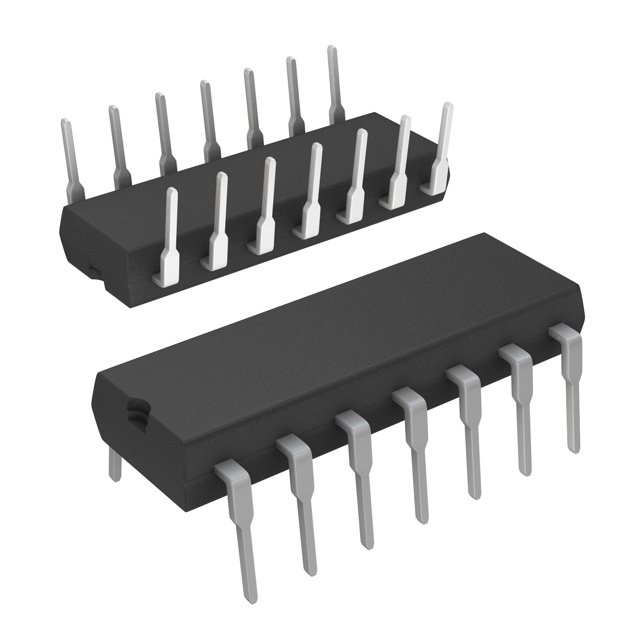Viz Specifikace pro podrobnosti o produktu.

PIC16LF1614-I/P
Product Overview
The PIC16LF1614-I/P belongs to the category of microcontrollers and is designed for use in various embedded control applications. This microcontroller is known for its low power consumption, high performance, and versatile features. It comes in a 14-pin PDIP package and is an essential component for electronic devices requiring intelligent control and processing capabilities.
Basic Information
- Category: Microcontroller
- Use: Embedded control applications
- Characteristics: Low power consumption, high performance
- Package: 14-pin PDIP
- Essence: Intelligent control and processing capabilities
- Packaging/Quantity: Available in bulk quantities
Specifications
- Architecture: 8-bit
- CPU Speed: Up to 32 MHz
- Program Memory Size: 3.5 KB
- RAM Size: 256 Bytes
- Digital I/O Pins: 12
- Analog Input Pins: 5
- Communication Interfaces: UART, SPI, I2C
- Operating Voltage Range: 1.8V to 5.5V
- Temperature Range: -40°C to 125°C
Detailed Pin Configuration
The detailed pin configuration of the PIC16LF1614-I/P microcontroller is as follows: 1. VDD (Pin 1) - Power supply voltage 2. RA0/AN0 (Pin 2) - Analog input/output or digital I/O 3. RA1/AN1 (Pin 3) - Analog input/output or digital I/O 4. RA2/AN2 (Pin 4) - Analog input/output or digital I/O 5. RA3/AN3 (Pin 5) - Analog input/output or digital I/O 6. RA4/T0CKI/C1OUT (Pin 6) - Timer input/capture or digital I/O 7. VSS (Pin 7) - Ground 8. RA7/OSC1/CLKIN (Pin 8) - Oscillator input or digital I/O 9. RA6/OSC2/CLKOUT (Pin 9) - Oscillator output or digital I/O 10. RC0/T1OSO/T1CKI (Pin 10) - Timer output or digital I/O 11. RC1/T1OSI/CCP2 (Pin 11) - Timer input/capture or digital I/O 12. RC2/CCP1 (Pin 12) - Capture/compare/PWM or digital I/O 13. VDD (Pin 13) - Power supply voltage 14. VSS (Pin 14) - Ground
Functional Features
- Low Power Consumption: Enables energy-efficient operation
- High Performance: Capable of handling complex tasks efficiently
- Versatile I/O Options: Supports both analog and digital interfaces
- Integrated Communication Interfaces: Facilitates seamless connectivity with other devices
- Flexible Operating Voltage Range: Allows for compatibility with various power sources
Advantages and Disadvantages
Advantages
- Low power consumption extends battery life in portable devices
- High-performance architecture enables rapid task execution
- Versatile I/O options provide flexibility in interfacing with sensors and actuators
- Integrated communication interfaces simplify connectivity with external devices
Disadvantages
- Limited program memory size may restrict the complexity of applications
- Restricted number of digital I/O pins may limit the connectivity options in some designs
Working Principles
The PIC16LF1614-I/P microcontroller operates based on the principles of embedded control, utilizing its CPU, memory, and I/O interfaces to execute programmed instructions. It interacts with external components through its pins and communication interfaces, enabling the control and monitoring of various processes in electronic systems.
Detailed Application Field Plans
The PIC16LF1614-I/P microcontroller finds application in diverse fields, including: - Consumer Electronics: Control systems for home appliances, smart devices - Automotive: Engine control units, dashboard displays - Industrial Automation: Process control, monitoring systems - Medical Devices: Patient monitoring, diagnostic equipment - IoT Devices: Sensor nodes, edge computing devices
Detailed and Complete Alternative Models
Some alternative models to the PIC16LF1614-I/P microcontroller include: - PIC16LF1613-I/P: Similar features with reduced I/O pins - PIC16LF1615-I/P: Enhanced memory capacity and additional peripherals - PIC16LF1618-I/P: Higher I/O count and extended operating temperature range
In conclusion, the PIC16LF1614-I/P microcontroller offers a balance of performance, power efficiency, and versatility, making it suitable for a wide range of embedded control applications.
Word Count: 611
Seznam 10 běžných otázek a odpovědí souvisejících s aplikací PIC16LF1614-I/P v technických řešeních
What is the operating voltage range of PIC16LF1614-I/P?
- The operating voltage range of PIC16LF1614-I/P is 1.8V to 3.6V.Can PIC16LF1614-I/P be used in battery-powered applications?
- Yes, PIC16LF1614-I/P is suitable for battery-powered applications due to its low power consumption.What are the key features of PIC16LF1614-I/P?
- Some key features of PIC16LF1614-I/P include 14KB Flash program memory, 256B EEPROM data memory, and multiple communication interfaces.Is PIC16LF1614-I/P suitable for motor control applications?
- Yes, PIC16LF1614-I/P can be used in motor control applications due to its integrated peripherals such as PWM modules.Can PIC16LF1614-I/P be programmed using a standard programmer?
- Yes, PIC16LF1614-I/P can be programmed using a standard in-circuit programmer.What development tools are available for PIC16LF1614-I/P?
- Development tools such as MPLAB X IDE and MPLAB Code Configurator support PIC16LF1614-I/P.Does PIC16LF1614-I/P have analog-to-digital conversion capabilities?
- Yes, PIC16LF1614-I/P features an integrated 10-bit ADC for analog-to-digital conversion.Can PIC16LF1614-I/P be used in temperature sensing applications?
- Yes, PIC16LF1614-I/P can be used in temperature sensing applications with the help of its analog input channels.What communication interfaces does PIC16LF1614-I/P support?
- PIC16LF1614-I/P supports communication interfaces such as SPI, I2C, and UART.Is PIC16LF1614-I/P suitable for IoT (Internet of Things) applications?
- Yes, PIC16LF1614-I/P is suitable for IoT applications due to its low power consumption and communication capabilities.

